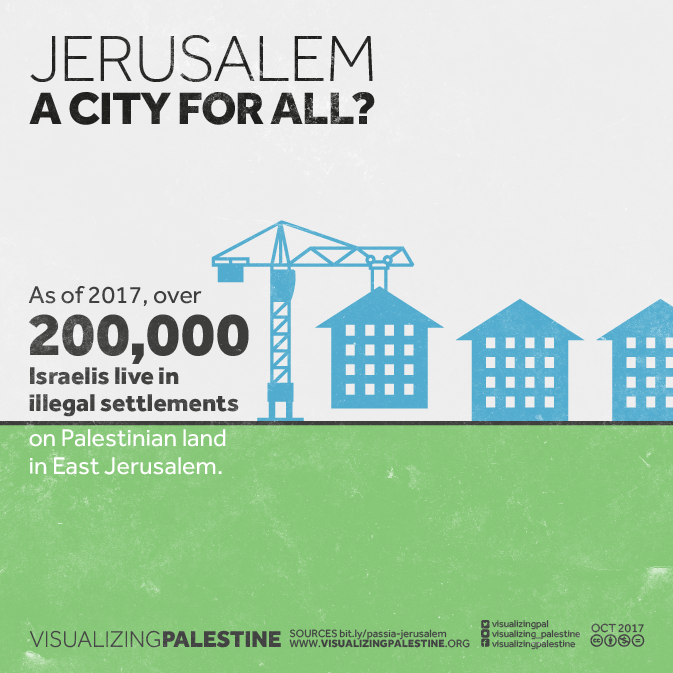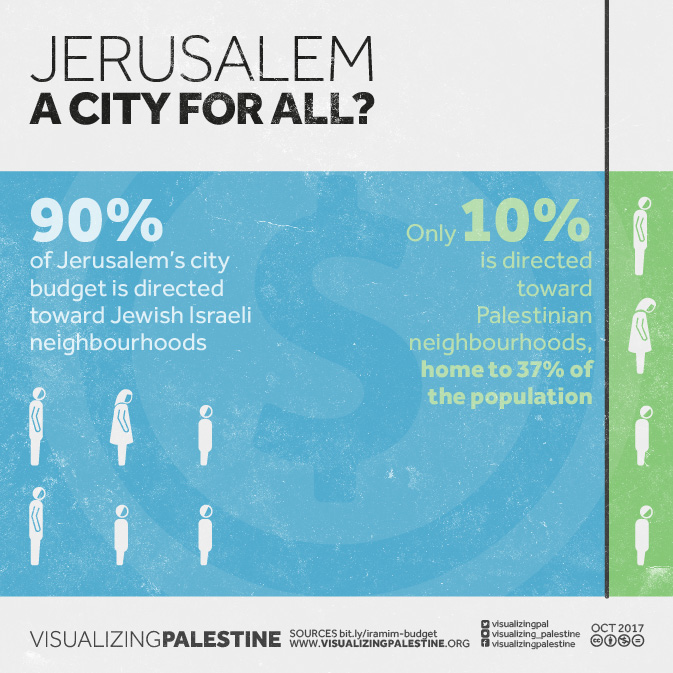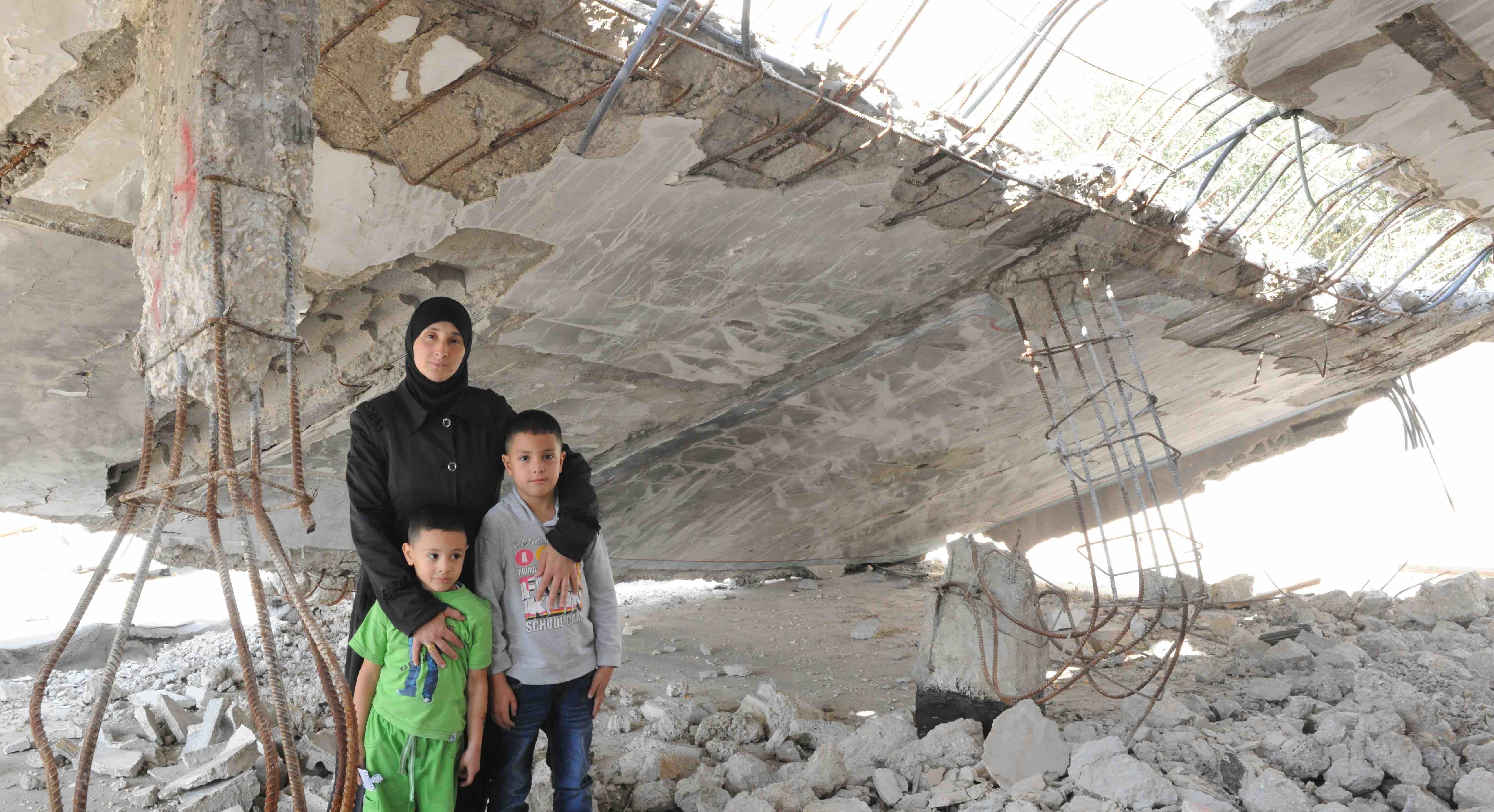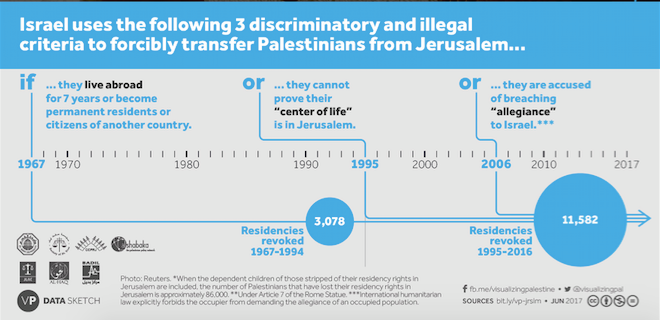Please note that on Jan. 22, 2018, we made some minor corrections to the information here and that the corrected version (below) should be the only one used or linked to. Thanks. ~eds.
1.
Some instances of ethnic cleansing (known in international law as “forcible transfer”) are “graphic” and easy to recognize– like the Myanmar government’s campaign against the Rohingya, the ethnic cleansings of Bosnia in the 1990s, or the Zionist/Israeli fighters’ anti-Palestinian campaigns of 1947-48. The ethnic cleansing that Israel has carried out in occupied East Jerusalem since June 1967 has been less “graphic” and less speedy than those; but over the past 50 years all Israeli governments, of both parties, have relentlessly pursued pursued the forcible transfer of as many Palestinians from the city as possible, mainly by using a complex maze of highly discriminatory laws and regulatory tools.
One person very familiar with this campaign is Nada Awad, Advocacy Officer with Al-Quds University’s Community Action Center (CAC). The CAC is one of a handful of organizations in East Jerusalem that provide legal-aid services to Palestinians, while they also do advocacy to publicize and bring an end to the occupying power’s extremely damaging practices in the city
One of the major means Israel uses to bring about forcible transfer is widespread revocation of the “right” of individual Jerusalem Palestinians to continue to reside in the city. This graphic from Visualizing Palestine summarizes how residency revocation has been used and expanded over the years:
More than 50 years after the Israeli military seized East Jerusalem and the rest of the West Bank in the 1967 war, under international law Israel remains only an “occupying power” in the city. This remains true in spite of the fact that Israel asserted its “annexation” of the city in 1967, and despite President Donald Tump’s more recent statement that he accepts that annexation. (Neither of those declarations has any validity under international law.)
Under international law, Israel is therefore obliged to abide by the provisions of the Fourth Geneva Convention of 1949 regarding the administration of territories held under military occupation and the restraints the Convention imposes on ways the occupying power can treat residents of the city. Those provisions, by the way, were adopted by the world community (including Israel) in 1949, in light of the abuses the world had seen during the Nazis’ then-recent occupation of large parts of Europe.
Two key provisions of the Fourth Geneva Convention are that:
- an occupying power may not move any portion of its own civilian population into the occupied area, and
- it may not undertake the forcible transfer of any part of the te
 rritory’s existing civilian population outside of it.
rritory’s existing civilian population outside of it.
Israel has done both of these things. Regarding moving its own citizens into occupied East Jerusalem, note that many Western mainstream media outlets don’t even count these people as “settlers” when they give counts of how many settlers there are in the West Bank– though East Jerusalem is, under international law, part and parcel of the occupied West Bank. Too many western journalists have attempted to normalize the situation of the East Jerusalem settlements, describing these massive, Israeli-only enclaves planted into East Jerusalem as “neighborhoods” rather than “settlements”. But under international law, they are settlements.
The implantation of those settlements has come at huge cost to East Jerusalem’s legitimate, indigenous Palestinian residents. To add further insult to this injury, the municipal services delivered to the Jewish and Palestinian parts of this (by design) highly segregated city reveal shocking disparities in resources:
 As these figures from the Israeli organization Ir Amim show (PDF), in 2014, the 37% of the whole of Jerusalem’s population who are Palestinians received only 10% of the municipal budget, while the 63% who are Israeli got a whopping 90%… That computes to a ratio of 5.2 : 1 in terms of per-capita spending by the municipality– though the Palestinian residents pay the municipal tax (arnona) at exactly the same rate as the city’s Jewish residents.
As these figures from the Israeli organization Ir Amim show (PDF), in 2014, the 37% of the whole of Jerusalem’s population who are Palestinians received only 10% of the municipal budget, while the 63% who are Israeli got a whopping 90%… That computes to a ratio of 5.2 : 1 in terms of per-capita spending by the municipality– though the Palestinian residents pay the municipal tax (arnona) at exactly the same rate as the city’s Jewish residents.
In a recent Skype conversation, the CAC’s Nada Awad noted that one of the current big threats being faced by East Jerusalem Palestinians is a proposal to redraw the Jerusalem municipal boundaries to exclude from the city two densely populated Palestinian areas, Kafr Aqab and Shuafat Refugee Camp, both located north of the city center.
These two city suburbs were included inside the municipal boundaries that Israel unilaterally redrew after 1967, at the time of its annexation attempt. But in more recent years, the Separation/Apartheid Wall that Israel built (quite illegally) deep inside the occupied West Bank was routed in a way that left these two suburbs outside the Wall. For its part, the heavily Israel-dependent Palestinian Authority, headquartered in nearby Ramallah, does not want to accept jurisdiction over the two areas.
The status of the two areas’ roughly 100,000 residents is thus very tenuous indeed. Their vulnerability is increased by the ever-present threat of home demolitions and other punitive measures that Israel holds over their heads.
The photo at the head of this blog post, taken by the CAC, is of Mrs. Nadia Abu Jamal and two of her three children, standing beside their former family home which was demolished in October 2015, a year after her husband was killed by the Israeli occupation forces while allegedly carrying out an attack.
The demolition of the family home was a clear act of collective punishment, such as is forbidden by Geneva-4. In addition, Mrs. Abu Jammal had her “right” to reside in Jerusalem revoked, and her children were stripped of the coverage they’d previously had under Israel’s national health insurance scheme. You can learn more about Mrs. Abu Jammal’s case in this joint statement prepared by the CAC, Al-Haq, Badeel, and Ad-Dameer. Or, click on the image at right to watch her own videotaped testimony.
2.
Jerusalem’s ancient and well-rooted population of Palestinians faces many other serious threats to its wellbeing and its survival, in addition to those mentioned here. We will try to describe more of these threats in materials to be posted here on the Just World Educational blog and website in the coming months.
As we know, though, in 2017 two large-scale political developments roiled the city:
- One was the Israeli government’s late-July attempt to control entry to the Al-Aqsa Mosque compound by installing metal security gates at all entrances– and the powerful grassroots resistance to that move that fairly quickly defeated the proposal, as we described here and here.
- The other was Pres. Trump’s early-December announcement that he recognized Jerusalem as Israel’s capital and would be moving the US Embassy to the city in the near future.
Ms. Awad, from her vantage-point in East Jerusalem, recalled that when the city’s Palestinians went into the streets in mass demonstrations and prayer gathering to protest the Al-Aqsa proposal, one of the main things she heard them say was, “We will not become Hebron.”
In Hebron, after the 1994 incident in which ultra-violent Jewish settler Baruch Goldstein massacred 29 Palestinian worshipers at the ancient Ibrahimi Mosque, the Israeli government intervened to split the mosque into two prayer areas-– one for the Palestinians Muslims and the other for the city’s (illegally implanted) Jewish settlers. Electronic entrance gates were a part of that decision– used all around the Ibrahimi Mosque as well as in the adjacent downtown market area, whose commerce was thereby effectively stifled and shut down.
In Jerusalem, Ms. Awad said, the Palestinians feared the new gates installed last summer would usher in similar developments along the way.
She said she had seen no existing political movement being behind the July resistance activities: “The religious leaders had to follow behind the street, and so did the political leaders.”
“The protesters were completely nonviolent,” she added, “though the reaction of the Israeli occupation forces certainly was not. Still, it is the first political victory I have ever seen! It gave us a lot of power to see that we could do something.”
She said the difference with Pres. Trump’s announcement was that there was no clear goal for Palestinian protesters to aim for.
3.
One goal that Ms. Awad and her colleagues in East Jerusalem’s legal-affairs community have been pursuing has been preparation of a powerful “joint submission” of legals facts about the city to the “Universal Periodic Review” that the UN’s Human Rights Committee will be making on Tuesday, January 23, of Israel’s performance under a slew of international human-rights instruments. This is the third “UPR” that the Human Rights Council will be making of Israel; the earlier ones were conducted in December 2008 and January 2013.
You can read the text of the submission that CAC, Al-Haq, and other Palestinian rights organizations have made to the UPR Review Committee here (PDF). Stay tuned, to see what happens on January 23!
We are very grateful to the CAC, to Ms. Awad, and Visualizing Palestine for their help in preparing this short report. Just World Educational is planning to build a whole resource page on our website offering a clear, easy-to-use collection of multi-media materials that can help concerned citizens worldwide to understand more about the complex and vulnerable situation of Jerusalem’s Palestinians.
If you would like to help us build this resource, please consider sending us a donation– either a one-time donation, or a monthly sum. Details for how to do so are here. Thanks!


